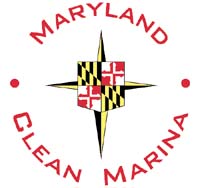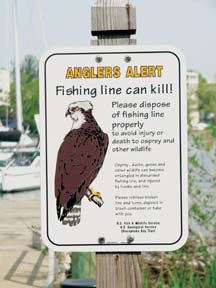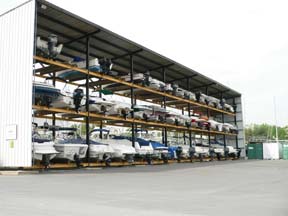Maryland's Clean Marinas Initiative:
Keeping Annapolis Waters Safe and Attractive
By Ann E. Dorbin

Marinas around Annapolis offer boaters respite and safe harbor. A sunny day with a summer zephyr carrying sailboats in and out of port, shooting the breeze with friends on deck or dock, perhaps a freshly grilled “cheeseburger in paradise” topping off a day fit for Jimmy Buffet himself—what could be more idyllic?
 But paradise is popular and our local marinas often feel the pressures of human impacts. Behind those romantic scenes can be water pollution caused by fuel leaks, hazardous wastes, sewage disposal, stormwater runoff, and other related factors. The Maryland Department of Natural Resources’ Maryland Clean Marina Initiative (CMI) promotes voluntary adoption of measures to reduce pollution from marinas, boatyards, yacht clubs, and recreational boaters. CMI certified facilities demonstrate that marina and boatyard operations can be managed to effectively minimize environmental impacts while at the same time providing boaters with an attractive, safe place to spend their leisure time. But paradise is popular and our local marinas often feel the pressures of human impacts. Behind those romantic scenes can be water pollution caused by fuel leaks, hazardous wastes, sewage disposal, stormwater runoff, and other related factors. The Maryland Department of Natural Resources’ Maryland Clean Marina Initiative (CMI) promotes voluntary adoption of measures to reduce pollution from marinas, boatyards, yacht clubs, and recreational boaters. CMI certified facilities demonstrate that marina and boatyard operations can be managed to effectively minimize environmental impacts while at the same time providing boaters with an attractive, safe place to spend their leisure time.
The Maryland Clean Marina Initiative began in 1998 in response to federal legislation requiring Maryland to step up its water pollution prevention efforts within several industries, including marinas and recreational boating. The legislation specifically targeted nonpoint source pollution, caused when rain and melting snow wash oil, grease, toxic chemicals, and other pollutants into waterways. CMI’s voluntary program assists marina, boatyard, and yacht club operators in protecting the resources that provide their livelihood: clean water and fresh air. CMI recognizes “Clean Marinas” through an awards program and conducts outreach activities to further promote environmentally responsible marina and boating practices. The Maryland Clean Marina Guidebook outlines comprehensive pollution prevention guidelines. The guidebook is written for managers of full service marinas with boatyards, but it is equally applicable to marinas with limited services, independent boatyards, and marine contractors. Operations that meet or exceed legal requirements and adopt a significant proportion of the best management practices suggested in the guidebook are recognized as Maryland Clean Marinas.
The Maryland Department of Natural Resources (DNR) developed CMI as a collaborative effort of individuals and businesses, aimed at improving the quality of the state’s waters from Deep Creek Lake to the Chesapeake Bay and in coastal bays. Several marinas partnered with DNR and the Marine Trades Association of Maryland, Boat/U.S. Clean Water Trust, Watershed Associates, Maryland Sea Grant, United States Coast Guard, Maryland Department of the Environment, Maryland Environmental Service, and Maryland Center for Environmental Training. Financial support for basic operations of the Clean Marina Initiative has been provided by the National Oceanic and Atmospheric Administration, the U.S. Environmental Protection Agency, and the State of Maryland. In addition to basic program administration, from 2000 to 2004, approximately $350,000 in cost share grants was awarded to marinas and boatyards for pollution prevention measures such as oil recycling tanks and dustless sanders. The program has served as a model for the National Park Service, Tennessee Valley Authority, and many other states and districts across the nation.
The Maryland Clean Marina Web site (www.dnr.state.md.us/boating/cleanmarina) lists seven basic steps to becoming a Maryland Clean Marina.
1. Learn about the Clean Marina Initiative
Attend a workshop, call the Clean Marina office or visit the Clean Marina Web page to obtain a copy of the Maryland Clean Marina Guidebook, pledge form, award checklist, and other program information.
2. Take the Clean Marina Pledge
By signing the pledge, participants commit to “do my part to keep Maryland’s waterways free of harmful chemicals, excess nutrients, and debris.” Pledging Marinas agree to identify opportunities and implement practices to control pollution associated with vessel maintenance and repair; petroleum storage and transfer; sewage disposal; solid, liquid, and hazardous wastes; stormwater runoff; and facilities management, as applicable. The original pledge certificate is displayed in a public area so that customers will be aware of a marina’s commitment to clean water.
3. Conduct a self-assessment of the property
Marinas assess their own facilities using the Clean Marina Award Checklist and the Maryland Clean Marina Guidebook.
4. Call upon a mentor or Clean Marina staff to answer any questions
Operators of most Clean Marinas and those who have helped to develop Maryland Clean Marina Initiative are available to assist others join. Clean Marina staff also offer routine informal visits to help marinas see where they stand with regard to Award criteria.
5. Schedule a confirmation visit
A representative from the DNR Clean Marina office and a marina operator from the Maryland Clean Marina Committee visit the marina seeking certification to verify the items checked on the Award Checklist.
6. Enjoy your rewards!
Maryland Clean Marinas are authorized to use the Clean Marina logo on their letterhead and in their advertising. They receive a certificate, a burgee or flag, and a free online business card on the Maryland Clean Marina Web site. Clean Marinas are also included in Clean Marina publications and public displays. Furthermore, Clean Marina staffers prepare a news release recognizing newly certified Clean Marinas.
7. Maintain your Clean Marina status
Annually, Clean Marinas confirm in writing that they continue to meet the award standards described on the Clean Marina Award Checklist. At least every third year, a Clean Marina representative will reaffirm Clean Marina status by another site visit.
 “When we started this program, we wanted to certify 25 percent of our 600 state marinas and boating businesses,” says Program Coordinator, Donna Morrow. “So far, we have 18 percent certified which, more importantly, represents more than 30 percent of the estimated commercial slips in the state.” “When we started this program, we wanted to certify 25 percent of our 600 state marinas and boating businesses,” says Program Coordinator, Donna Morrow. “So far, we have 18 percent certified which, more importantly, represents more than 30 percent of the estimated commercial slips in the state.”
Morrow, who conducts the on site evaluations, says the prospect of a state evaluation can be intimidating to some marina managers. To put them at ease, she brings along the manager of an approved Clean Marina. “Small business owners can be reluctant to invite the government to inspect their property. But they soon realize that we don’t have regulatory authority over their business (that is handled by the Maryland Department of the Environment), so they don’t need to be apprehensive. We also provide confidential compliance assistance for those who need it.”
The certification process doesn’t end with the certificate and flag; marinas must continue to meet the certification standards. “Once the marina becomes certified, they sign a written ‘Affirmation of Good Standing’ for the first two years,” Morrow explains. “Then, in the third year, a staff member goes back out to recertify them.”
Although the process can be demanding, participants say it is worth the effort. Besides the free publicity that comes with membership, certification can mean more customers as boaters increasingly look for the Clean Marina logo and seek out certified facilities.
Mears Marina, located within walking distance of downtown Annapolis, lists among its attributes not only its recreational amenities, service facilities, and convenient location, but also the following policies:
• Recycle oil, antifreeze, batteries, cardboard, paper, and glass
• Participate in oyster restoration project
• Provide a trash disposal area with clearly marked recycling
• Pick up trash on the grounds daily
• Filter cloth is placed under every boat on land
• Use dustless sanders
Stuart Chaney is managing owner of the 1,300 slip Herrington Harbour Marinas, one of the original partners in the formation of CMI. Chaney describes his facilities as “the neck of an hourglass. People from all over the Washington-Baltimore region come here to get into their boats and explore the Chesapeake. We’ve got a great opportunity to educate them on how to enjoy the Bay without polluting it. I especially like to teach by example. The Maryland Clean Marina Initiative is an example of how industry can take the lead and to improve the environment and at the same time make good business sense.”
 Chaney explains that today’s boat owners have changing perspectives. “People are much more environmentally sensitive. Today’s boater is a different boater, a new boater with more of an appreciation for the Bay.” Chaney explains that today’s boat owners have changing perspectives. “People are much more environmentally sensitive. Today’s boater is a different boater, a new boater with more of an appreciation for the Bay.”
The support and patronage of boaters is a key factor in the success of the Maryland Clean Marina Initiative. In order to promote environmentally responsible boating, CMI has incorporated a “Clean Boating Lesson Plan” and other educational materials for boaters into the Program. Other materials, such as clean boating tip cards and free oil absorbent pads, are being distributed to boaters through marinas and at public events.
For more information, a complete listing of Maryland Clean Marinas, or to download the Maryland Clean Marina Guidebook, visit www.dnr.state.md.us/boating/cleanmarina or contact:
Program Coordinator Donna Morrow
Maryland Clean Marina Initiative
Department of Natural Resources
580 Taylor Ave., E-2
Annapolis, MD 21401
410.260.8770 voice / 410.260.8404 fax
e-mail: dmorrow@dnr.state.md.us
These marinas meet the rigorous pollution prevention standards established by the Maryland Clean Marina Committee and the Department of Natural Resources. The operators have voluntarily adopted measures to control pollution associated with marina operations and stand as notable examples of the conservation ethic: individual responsibility for healthy land and water.
• Bay Ridge Civic Association Marina
• Bert Jabin’s Yacht Yard
• Chesapeake Harbour Marina
• Eastport Yacht Club
• Mears Marina
• Port Annapolis Marina
• Saefern Saddle and Yacht Club
• Sandy Point State Park Marina
• Whitehall Yacht Yard
Clean Marina Partners are not true marinas, yet they promote the pollution prevention goals of the Clean Marina Initiative. Managers of Clean Marina Partners voluntarily incorporate pollution prevention measures into their daily operations and promote the conservation ethic: individual responsibility for healthy land and water.
• Anchorage Community Marina and Swim Club, Annapolis
• Twin Harbors Community Marina, Arnold
• Certified Clean Marinas Pledges
The following marinas have pledged to do their part to keep Maryland’s waterways free of harmful chemicals, excess nutrients, and debris.
• Carrs Creek Marina - MWR Annapolis - 8/1/05
• Eastport Yacht Yard - Annapolis - 8/10/02
• Hillsmere Shore Community Marina - Annapolis - 2/20/04
• Olde Towne Marina - Annapolis - 1/31/02
• Petrini Shipyard - Annapolis - 3/29/02
• Pleasure Cove Marina - Annapolis - 2/1/00
• Sarles Boat and Engine Shop—Annapolis, 1/19/2006
• W & P Nautical - Annapolis - 2/20/04
The Marine Trades Association of Maryland (MTAM), in cooperation with regional marinas, boatyards and county governments, is once again spearheading a project to collect and recycle used shrink-wrap from boats. The following boatyards and landfills will designate a specific area for collecting the used material for storage.
Anyone dropping off shrink-wrap must cut out zippers, windows, and ties and fold the shrink wrap into as small a bundle as possible to conserve space. Other boatyards interested in being a collection site should contact MTAM at 410.269.0741 or director@mtam.org. Boaters should confirm availability with private marinas by calling ahead. The 2006 locations are: Anne Arundel County: Herrington Harbour North, 389 Deale Road, Tracey’s Landing, 410-867-4343; Port Annapolis Marina, 7076 Bembe Beach Road, Annapolis 410-269-1990; Atlantic Marina Resort, 2010 Knollview Drive, Pasadena 410-437-6926 Back |

